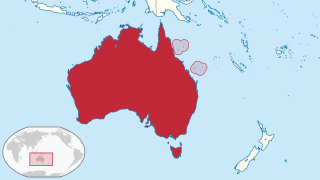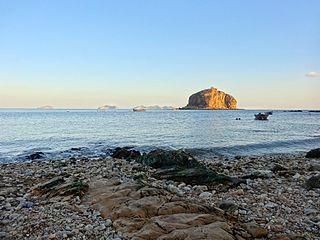
The Coral Sea Islands Territory is an external territory of Australia which comprises a group of small and mostly uninhabited tropical islands and reefs in the Coral Sea, northeast of Queensland, Australia. The only inhabited island is Willis Island. The territory covers 780,000 km2 (301,160 sq mi), most of which is ocean, extending east and south from the outer edge of the Great Barrier Reef and includes Heralds Beacon Island, Osprey Reef, the Willis Group and fifteen other reef/island groups. Cato Island is the highest point in the Territory.

An islet is a very small, often unnamed island. Most definitions are not precise, but some suggest that an islet has little or no vegetation and cannot support human habitation. It may be made of rock, sand and/or hard coral; may be permanent or tidal ; and may exist in the sea, lakes, rivers or any other sizeable bodies of water.

The Pearl and Hermes Atoll, also known as Pearl and Hermes Reef, is part of the Northwestern Hawaiian Islands, a group of small islands and atolls that form the farthest northwest portion of the Hawaiian island chain. The atoll consists of a variable number of flat and sandy islets, typically between five and seven. More were noted in historical sources but have since been lost to erosion and rising sea levels.

Caroline Island is the easternmost of several uninhabited coral atolls comprising the southern Line Islands in the central Pacific Ocean nation of Kiribati.

Trunk Bay is a body of water and a beach on St. John in the United States Virgin Islands. Trunk Bay is part of the Virgin Islands National Park. Trunk Bay is named for the Leatherback turtle, which is endemic to the USVI and are locally known as trunks. The beach area is divided into two halves, the main Trunk Bay beach and swim area and Burgesman Cove which is located on the west end of Trunk Bay near Jumby Bay. Its amenities include a snack bar, showers and restrooms, a lifeguard, and an underwater trail for snorkeling its coral reef. Trunk Bay has consistently been voted one of the top beaches in the world.
Low Island is an island lying about 25 km (16 mi) north-east of Port Douglas in Trinity Bay, North Queensland. It is around 2 hectares or 0.02 square km in size. It is part of the Low Isles, along with Woody Island, an uninhabited coral and mangrove island. The isles are surrounded by 55 acres (220,000 m2) of reef. The Low Islets are a Marine National Park Zone. Day visitors come to the island on a daily basis via a number of commercial operators. There is a lagoon where private vessel can moor or anchor outside the reef protection markers overnight, but there is no overnight accommodation on the island. There is a weather station and an active lighthouse. No fishing is allowed in the lagoon or within a buffer zone around the islands. Motorised water sports are not permitted in the locality. There is a 6 knot limit. No open fires of any sort or dogs permitted on either island. No island access between sunset and sunrise.

The Hawaiian Poi Dog is an extinct breed of pariah dog from Hawaiʻi which was used by Native Hawaiians as a spiritual protector of children and as a source of food.
Lunga is one of the Slate Islands in the Firth of Lorn in Argyll and Bute, Scotland. The "Grey Dog" tidal race, which runs in the sea channel to the south, reaches 8 knots (15 km/h) in full flood. The name "Lunga" is derived from the Old Norse for "isle of the longships', but almost all other place names are Gaelic in origin. The population was never substantial and today the main activity is an adventure centre on the northern headland of Rubha Fiola. The surrounding seas are fished for prawns and scallops and there is a salmon farm off the south eastern shores. The Special Area of Conservation of which the island is part hosts a growing number of outdoor leisure pursuits.
Seal Island, Seal Islands and similar may refer to:
Bellamy Cay is an island in the British Virgin Islands, located entirely within Trellis Bay on Beef Island. Formerly called Blanco Islet, this island is named after its most famous resident, "Black Sam" Bellamy, the "prince of pirates".

Cockroach Island is an uninhabited island of the British Virgin Islands in the Caribbean. It is located near North Sound, Virgin Gorda, amongst a collection of islands known as "The Dogs" or "The Dog Islands".

George Dog is an uninhabited island of the British Virgin Islands in the Caribbean. It is located in a smaller sub-group of islands referred to as "The Dogs" to the northwest of Virgin Gorda.
Great Dog Island is an uninhabited islet of the British Virgin Islands in the Caribbean. It is located in a smaller sub-group of islands referred to as the Dog Islands, or more commonly, "The Dogs". Other islets in The Dogs include Little Seal Dog Island, East Seal Dog Island, West Dog Island and George Dog Island, all of which are to the northwest of Virgin Gorda.
Little Seal Dog Island is an uninhabited islet of the British Virgin Islands in the Caribbean. It is located in a smaller sub-group of islands referred to as the Dog Islands, or more commonly, "The Dogs". Other islets in The Dogs include Great Dog, East Seal Dog and George Dog, all of which are to the northwest of Virgin Gorda.
West Dog Island is an uninhabited islet of the British Virgin Islands in the Caribbean. It is located in a smaller sub-group of islands referred to as the Dog Islands, or more commonly, "The Dogs". Other islets in The Dogs include Little Seal Dog Island, East Seal Dog Island and George Dog Island, all of which are to the northwest of Virgin Gorda.

Dog Islands are a small group of islets among the British Virgin Islands in the Caribbean.

The fauna of the United States Virgin Islands consists of 144 species of birds, 22 species of mammals, 302 species of fish and 7 species of amphibians. The wildlife of the U.S.V.I. includes numerous endemic species of tropical birds, fish, and land reptiles as well as sea mammals. The only endemic land mammals are six species of native bats: the greater bulldog bat, Antillean fruit-eating bat, red fruit bat, Brazilian free-tailed bat, velvety free-tailed bat and the Jamaican fruit bat. Some of the nonnative land mammals roaming the islands are the white-tailed deer, small Asian mongoose, goats, feral donkeys, rats, mice, sheep, hogs, dogs and cats.











